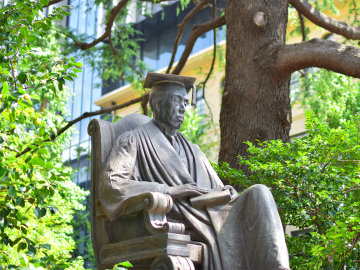Recent Legislation in Japan (Criminal Law)
Criminal Regulations Regarding Child Pornography in Japan: Revisions to the Child Pornography Act and Related Issues
Assistant Professor Dr. Yu Amada
(Research Staff, Faculty of Law)
(May 6, 2016)
1. Introduction
On June 18, 2014, the “Partially Revised Act on Punishment of Acts Relating to Child Prostitution and Child Pornography, and the Protection of Children” (Act No. 79 of 2014; hereinafter referred to as the “Revised Law”) was drafted. This Revised Law was officially published on June 25, 2014 and came into force on July 15th of the same year. With the partial revisions in 2004 to the “Act on Punishment of Acts Relating to Child Prostitution and Child Pornography, and the Protection of Children” (Act No. 52 of 1999; hereinafter referred to as the “Law”), the range of child pornography-related acts punishable under the Law was expanded. However, because the former Law did not primarily target so-called simple possession (possession without the accompanying intent of providing such materials to another person) for punishment purposes, it was not consistent with international trends in this area. The Revised Law was established and enforced based on such trends (the content of the Revised Law and its overview can be found on the Ministry of Justice website at http://www.japaneselawtranslation.go.jp/law/detail/?id=2592&vm=04&re=01&new=1, http://www.moj.go.jp/keiji1/keiji11_00008.html [last visited May 6, 2016]).
In the following sections, I will present an overview of the Revised Law (Section 2) and identify issues that have arisen as a result of these revisions with the aim of clarifying matters related to the Revised Law (Section 3).
2. Overview of the Revised Law
(1) Title modifications
The title of the Law was modified to the “Act on Regulation and Punishment of Acts Relating to Child Prostitution and Child Pornography, and the Protection of Children” (emphasis reflects the revised text). The title was revised to add the word “Regulation” because, as will be discussed below in Section 2.3, the Revised Law included new general prohibition provisions to accompany the regulations outlined in Article 3-2.
(2) Changes in the definition of “Child Pornography” (Article 2(3)(iii))
Article 2(3)(iii) of the former Law, which covers the definition of “Child Pornography” (hereinafter referred to as “Pornography as defined in Item (iii),” so-called “san-gou poruno”), previously defined the term as “any pose of a child wholly or partially naked, which arouses or stimulates the viewer’s sexual desire.” This definition was stipulated by the Revised Law to mean “any pose of a child wholly or partially naked, which the sexual body parts of the child (genital organs or the parts around them, buttocks or breasts) are exhibited or emphasized and arouses or stimulates the viewer’s sexual desire” (emphasis reflects the revised text).
According to explanations provided by lawmakers, the Revised Law adds the condition “which the sexual body parts of the child (…) are exhibited or emphasized” to Pornography as defined in Item (iii), thus clarifying the intent behind judgments regarding the objective content of images that correspond to Pornography as defined in Item (iii) (See Mayumi Tsuboi, Jidou-kaishun, jidou-poruno ni kakaru koui-tou no shobatsu oyobi jidou no hogo-tou ni kansuru houristu no ichibu wo kaisei suru houritsu ni tsuite [Comments on the Amendment of the Act on Punishment of Acts Relating to Child Prostitution and Child Pornography, and the Protection of Children], 66 (11) Hōsō Jihō [Lawyers’ Association Journal], 29, 39 (2014)).
(3) Prohibition of Child Prostitution, Possession of Child Pornography, and Acts Relating to Sexual Exploitation and Sexual Abuse of Children (Article 3-2)
The following general prohibition provision was added by the Revised Law: “No person shall commit child prostitution, unlawfully possess child pornography or retain electromagnetic records, which depict the pose of a child which falls under any of the categories of paragraph 3 of Article 2, in a visible way or commit any other acts relating to sexual exploitation or sexual abuse of children.”
(4) Possession and Provision of Child Pornography and Other Related Acts (Article 7(1))
The Revised Law established a new provision stating “any person who possesses child pornography for the purpose of satisfying one’s sexual curiosity (limited to those who have come to possess it voluntarily and are clearly deemed to as such) shall be sentenced to imprisonment with work for not more than one year or a fine of not more than 1,000,000 yen.”
Until recently, the former Law targeted, for punishment purposes, only the production, provision, and possession with the purpose of distributing such materials. However, according to lawmakers, it is not enough to concentrate solely on the suppliers of child pornography if the goal is to eradicate these materials. Rather, we need to target the consumers of such content for punishment as well (See Tsuboi, supra 49).
(5) New Punishments for the “Secret” Production of Child Pornography (Article 7(5))
In addition, the following prohibition was added by the Revised Law: “(…) any person who produces child pornography by secretly depicting the pose of a child which falls under any of the categories of paragraph 3 of Article 2, in photographs, recording media containing electromagnetic records or any other medium shall be punished (…).”
Until recently, the “secret” production of child pornography was not targeted for punishment purposes. However, such actions may violate the dignity of childhood, encourage the tendency to target children for sexual activity, and impact the personal rights of children; further, such conduct must be repudiated due to the risk of the material being circulated (See Tsuboi, supra 56). Accordingly, lawmakers have made the “secret” production of child pornography a crime, punishable in the same way as the production of child pornography for the purpose of distribution (See Article 7(3)) and the production of “child pornography by having a child pose” (See Article 7(4)).
3. Issues Resulting from Changes to the Law
Three primary issues have arisen as a result of the changes reflected in the Revised Law (Takuya Watanabe, Jidou-poruno no keiji-kisei: kaisei no keii to ronten [Criminal Regulation of Child Pornography: Background to the Revision of the Child Pornography Act and Related Issues], 41 Keiji-hou Journal [Criminal Law Journal], 35 (2014); See also, Hisashi Sonoda, Jidou-poruno-kinshi-hou no seiritsu to kaisei [Establishment and Revision of the Law against Child Pornography], in Kaisei-jidou-poruno-kinshi-hou wo kangaeru [Considering Revisions to Laws Against Child Pornography], 9 (Hisashi Sonoda & Masahiro Sogabe eds., 2014)).
The first issue is the concept of “child pornography.” The purpose of the Revised Law is “to protect the rights of children” from “sexual exploitation and sexual abuse” (Article 1). With its relationship to the interests protected under the Law, the interpretation of each condition attached to Pornography as defined in Item (iii) becomes an important issue.
The second issue is the regulation of the “possession” of child pornography. The theoretical rationale behind each condition attached to Article 7(1) will be problematic. In addition, it is not obvious whether or not the condition “for the purpose of satisfying one’s sexual curiosity” and “to possess it [child pornography] voluntarily” in Article 7(1) will restrict punishment.
The third issue is the regulation of the “production” of such materials. Regarding the simple production of child pornography, which was not punishable under the Law, it will be necessary to clarify the rationale behind the legal grounds for the particular unlawfulness of the “secret production” of such materials pursuant to Article 7(5).
4. Outlook
I have provided a summary of the Revised Child Pornography Law and pointed out several issues that emerged after the Revised Law was passed. As a final note, I would like to present the pros and cons of regulating certain forms of pornography that involve fictional children. The question is whether the production and distribution of such creative graphical works that do not involve real children as subjects infringe in any meaningful way on the rights of children. This point was the subject of litigation before the Tokyo District Court on March 15, 2016 (2016WLJPCA03156003), where the question was whether depictions of nude girls created by computer graphics (CG) constituted “child pornography” under the Revised Law. Of the 34 graphic computer images that the Court reviewed, three were deemed to be “child pornography”; these were admitted as evidence of the production of child pornography by the defendant. (The decision is under appeal.) The outcome of this case will no doubt be the subject of much scrutiny.




